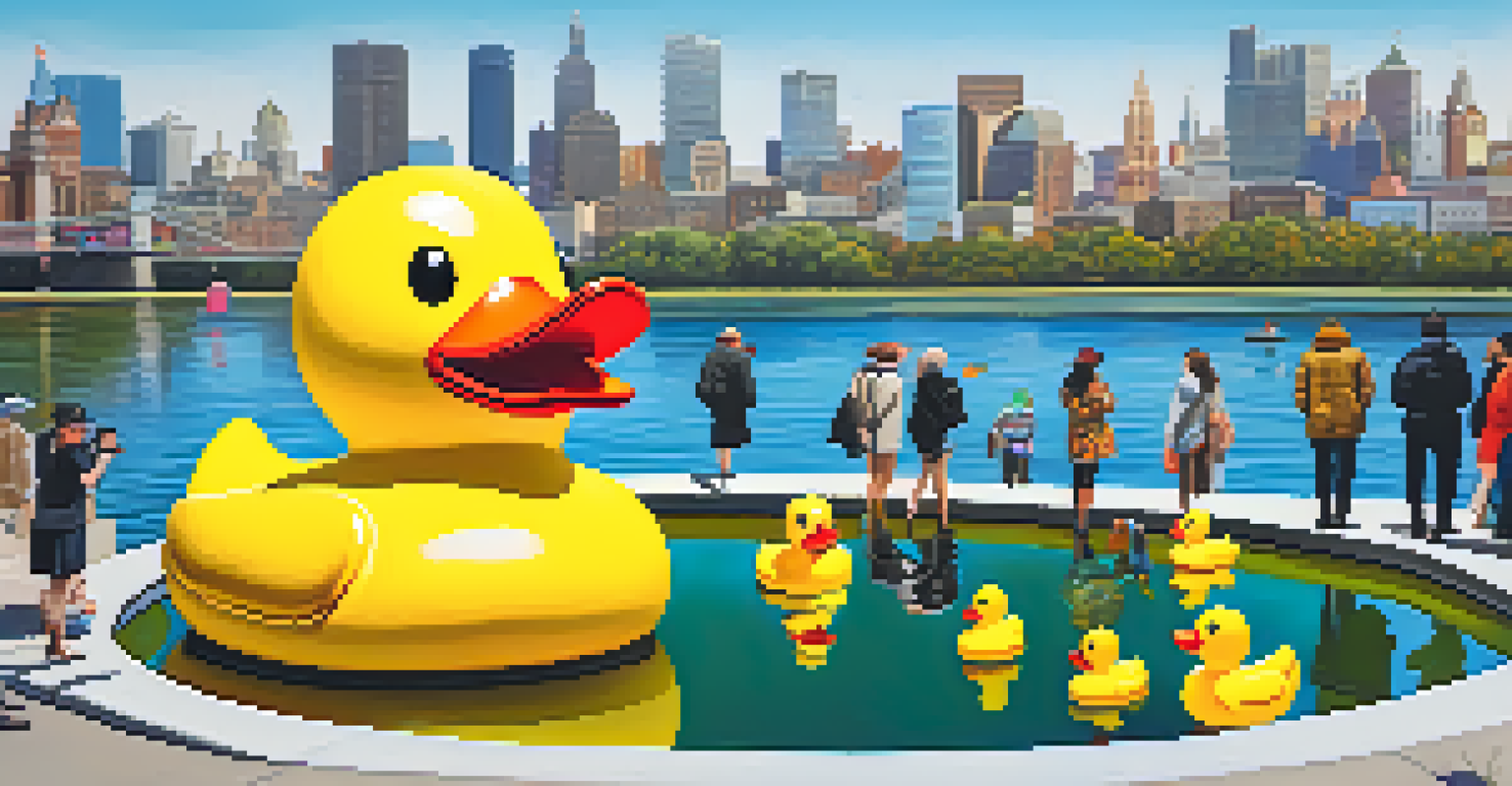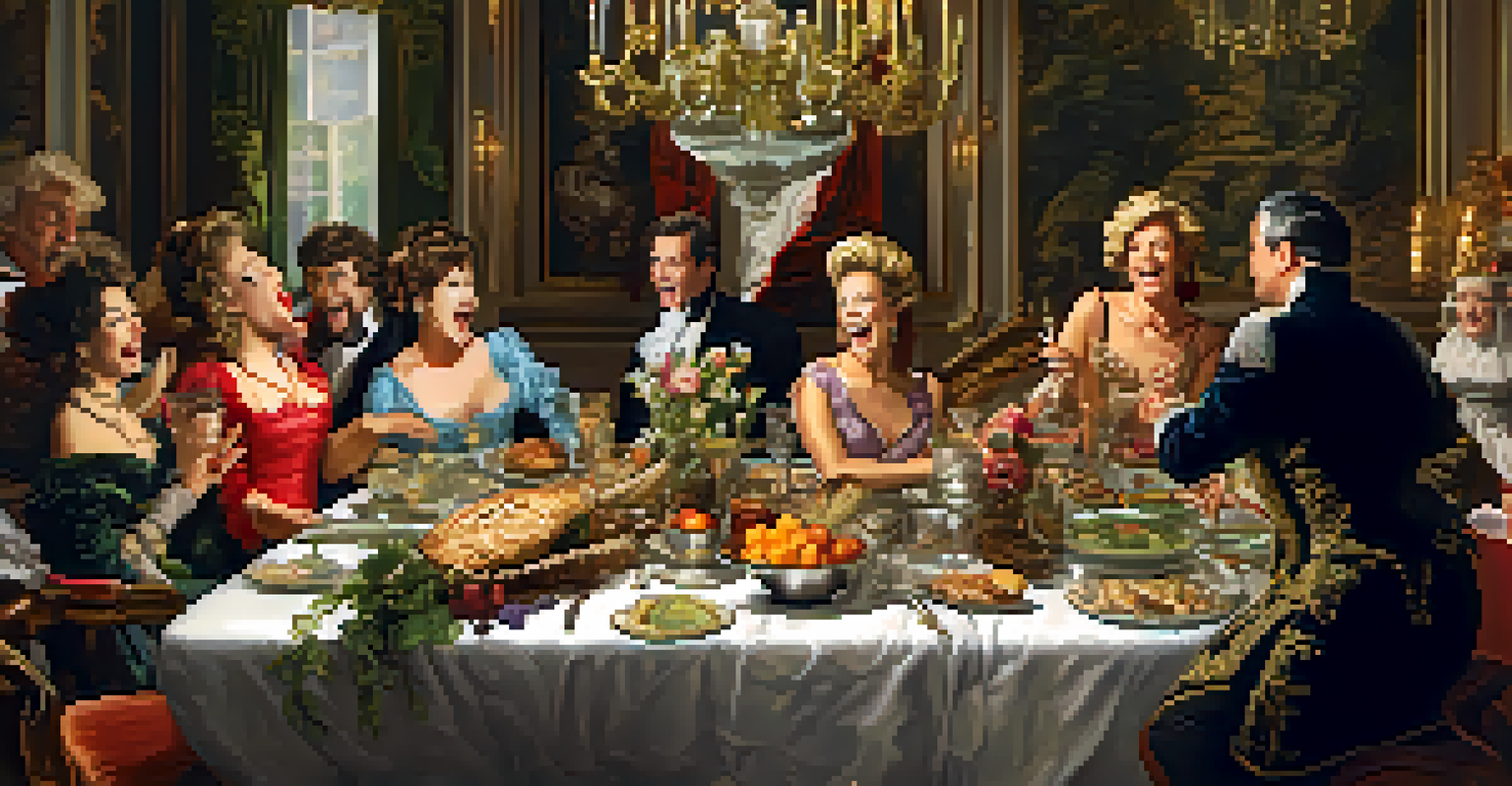The Role of Humor in Artistic Movements Throughout History

The Origins of Humor in Early Art Forms
Humor has been a part of human expression since ancient times. Early cave paintings often depicted humorous scenarios, possibly as a way to connect with the community through shared laughter. This trend varied from playful representations of animals to exaggerated portrayals of human interactions, showcasing a lighthearted approach to storytelling.
Humor is the universal solvent against the abrasive elements of life.
In ancient civilizations, like the Egyptians and Greeks, humor found its way into art through satire and caricature. For instance, Greek pottery often featured comedic scenes from daily life, blending art with social commentary. This interplay not only entertained but also critiqued societal norms, making humor an essential aspect of artistic expression.
As these early forms of art laid the groundwork, they paved the way for humor as a vital tool in engaging audiences. Humor’s ability to resonate with people transcends time, allowing artists to connect with viewers on a more personal level, even in ancient contexts.
Renaissance: A Period of Wit and Satire
The Renaissance sparked a revival of classical ideas, including humor, as artists began to explore human emotion and intellect. Paintings from this era often included satirical elements, subtly poking fun at the elite and their follies. Artists like Hieronymus Bosch used humor to convey deeper moral lessons through absurd and fantastical imagery, showcasing a unique blend of comedy and critique.

Furthermore, playwrights such as Shakespeare incorporated humor into their works, influencing visual arts and performances alike. His witty dialogue and clever wordplay not only entertained audiences but also encouraged artists to depict comedic scenes in their paintings and sculptures. This integration of humor into various art forms enriched the cultural landscape of the time.
Humor's Historical Roots in Art
Humor has been integral in art since ancient times, fostering community connections through shared laughter and social commentary.
The Renaissance ultimately demonstrated how humor could serve as a vehicle for social reflection. The clever use of satire allowed artists to challenge societal norms while engaging audiences in thought-provoking ways, making humor an integral part of this artistic movement.
The Baroque Era: Exaggeration and Irony
During the Baroque era, humor took on a more dramatic form, characterized by exaggeration and irony. Artists like Caravaggio employed striking contrasts and exaggerated expressions to evoke emotional responses, sometimes laced with dark humor. This approach allowed viewers to experience a range of feelings, from joy to discomfort, as they navigated the complexities of human existence.
Art is the most beautiful of all lies.
Additionally, the use of irony became prevalent, as artists began to manipulate visual narratives to create unexpected twists. For example, works like 'The Supper at Emmaus' by Caravaggio featured moments of surprise that elicited laughter while simultaneously prompting deeper contemplation. This blend of humor and irony made Baroque art compelling and layered.
As the Baroque movement unfolded, humor emerged as a means to explore the human condition. By combining emotional depth with comedic elements, artists could engage audiences in a way that was both entertaining and thought-provoking, reflecting the complexities of life during this vibrant period.
Romanticism: Humor as a Reflection of Emotion
In the Romantic era, artists began to focus on individual emotions, often incorporating humor to illustrate the complexities of the human experience. This movement highlighted the tension between reason and emotion, allowing humor to serve as a release valve. For instance, works by artists like Eugène Delacroix included whimsical elements that contrasted with intense themes, showcasing a multifaceted approach to art.
The use of humor during this period also allowed artists to challenge societal expectations. They often portrayed characters in absurd situations that evoked laughter while inviting viewers to reflect on the absurdities of life. This playful engagement revealed the artists' critiques of societal norms and their exploration of personal identity.
Renaissance to Modernism: Evolving Humor
From the Renaissance's witty satire to Modernism's absurdity, humor has continuously shaped artistic expression and societal critique.
Romanticism ultimately demonstrated that humor could coexist with serious themes, enriching the emotional landscape of art. By using humor as a tool for reflection, artists could connect with audiences on a deeper level, making their work resonate in unique and meaningful ways.
Modernism: Absurdity and the Avant-Garde
As the 20th century emerged, Modernism brought forth a wave of artistic experimentation, with humor playing a pivotal role in the avant-garde movement. Artists began to embrace absurdity, using humor to challenge traditional artistic conventions. This shift is evident in the works of figures like Marcel Duchamp, whose famous 'Fountain' turned everyday objects into art, provoking laughter and thought in equal measure.
Moreover, the Dada movement, with its emphasis on spontaneity and absurdity, often employed humor to critique the chaos of contemporary society. Artists used nonsensical elements and playful compositions to subvert expectations, inviting viewers to reconsider their understanding of art. This radical approach showcased humor as a powerful tool for social commentary.
Modernism ultimately redefined the role of humor in art, allowing it to serve as a lens through which societal issues could be examined. By embracing the absurd, artists could engage audiences in new and innovative ways, ensuring that humor remained a vital part of the artistic discourse.
Postmodernism: Irony and Cultural Commentary
In the realm of Postmodernism, humor took on a self-referential quality, often characterized by irony and cultural commentary. Artists like Jeff Koons and Cindy Sherman utilized humor to challenge perceptions of identity and consumer culture. By blending high art with kitsch, they invited audiences to laugh while also reflecting on the complexities of modern life.
This era also saw the rise of parody and pastiche, where humor served as a way to critique established artistic norms. By reinterpreting previous styles and genres, artists could expose the absurdities present within the art world itself. This playful approach not only entertained but also encouraged deeper discussions about authorship and originality.
Future of Humor in Contemporary Art
Contemporary artists utilize humor to address social issues, leveraging digital platforms to engage wider audiences in meaningful dialogue.
Postmodernism ultimately reaffirmed the significance of humor in art, using it as a means to question established narratives. Through irony and satire, artists could engage with cultural issues in a way that was both accessible and thought-provoking, ensuring that humor remained a cornerstone of artistic expression.
The Future of Humor in Contemporary Art
As we look toward the future, humor continues to evolve in contemporary art, adapting to the changing cultural landscape. Artists are increasingly using humor to address pressing social issues, often blending comedy with activism. This integration allows for a unique dialogue that encourages audiences to engage with serious topics through a lens of levity.
Furthermore, the rise of digital media has transformed how humor is expressed in art. Platforms like Instagram and TikTok have given artists new avenues to share their work, often incorporating humor in short, digestible formats. This accessibility allows for a broader audience to connect with art, breaking down traditional barriers and inviting diverse interpretations.

Ultimately, the future of humor in art looks bright, with artists continuously finding innovative ways to engage audiences. As humor remains a powerful tool for connection and reflection, it will undoubtedly play a vital role in shaping the artistic landscape for years to come.